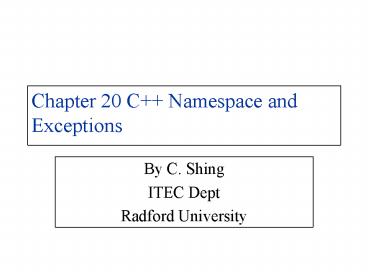Chapter 20 C Namespace and Exceptions PowerPoint PPT Presentation
1 / 15
Title: Chapter 20 C Namespace and Exceptions
1
Chapter 20 C Namespace and Exceptions
- By C. Shing
- ITEC Dept
- Radford University
2
Objectives
- Understand how to create namespace
- Understand how to throw exception
- Understand how to handle exception
3
Namespace
- Contains unique names which are defined
- in the space
- The names are unique in their scope
- Can be defined more than once,
- such as define the specification once and
- define the implementation the second time
4
Namespace (Cont.)
- Form
- define
- namespace yournamespace
- class specification/implementation
- Invoke the names
- using namespace yournamespace
5
Example
- Namespaces for using data structures
- linked list, stack, queue and tree
- name.h
6
Example (Cont.)
- Use namespaces for data structures
- linked list, stack, queue and tree
- uselist.cpp
- usestack.cpp
- usequeue.cpp
- usetree.cpp
7
Exception
- An unusual situation that makes the code
- not working as normal
- Handle unusual situation so they will be
- executed normally
- If exception not handled, then system will
- execute terminate to end the execution of
- the program
8
Exception (Cont.)
- Form
- try
- exeception could occur here
- catch (exception type1)
- exeception handled here
- catch (exception type2)
- exeception handled here
9
Exception (Cont.)
- If exception happens in try block, the code ended
- at throw line. Then control moved to catch block
- and finished in the block.
- If no exception happen in try block, then control
- will move to the statement after the catch
block. - When catch exception, it will start from the
- 1st catch block down one by one until it finds
the - corresponding exception type
10
Handle Exception
- Use library routines
- Use user defined exeception
11
Handle Exception library exception
- Example
- bubbleclass_template.cpp
- bubbleclasstemplate_data.txt
12
Handle Exception user-defined exception
- Write function that throw exception
- Can have any possible exception type
- returntype functionname ()
- if () throw exception1
- Only exception1, exception2, listed are
possible - returntype functionname ()
- throw exception1, exception2,
- if () throw exception1
13
Handle Exception user-defined exception (Cont.)
- Write function that throw exception (Cont.)
- If not in case 1 or 2, then the system will
- terminate abnormally
14
Handle Exception user-defined exception (Cont.)
- The exception can be a class and arranged
- in inheritance hierarchy
- superclass must throw all the exceptions that
- all subclasses have thrown
- If the exception is not caught in the subclass
that - was thrown, it must be caught from the bottom of
- the hierarchy up.
15
References
- Deitel Deitel C How to Program, 4th ed.,
- Chapter 23, Prentice Hall

